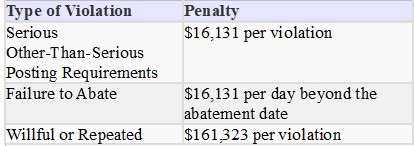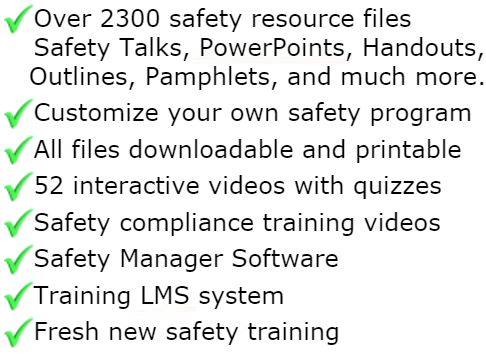
Flammable Materials & Storage Safety
Safety Training Session Tips?
Flammable liquids, material and safe storage programs are an important part of a fire prevention program. Statistics indicate that over 21 percent of industrial fires and 15 percent of office fires start with the ignition of a flammable or combustible liquid. What makes these substances so hazardous? Flammable liquids burn at relatively low temperatures making them susceptible to catching fire or exploding when set off by even the smallest spark.
Take the time to know what flammable liquids you're working with and what the necessary precautions are. Remember flashpoints, auto ignition temperatures, and the basic principles of air and vapor mixtures. When flammable liquid is within the explosive range, you need to take extra precautions and follow the rules. Flammable liquids are used in hundreds of thousands of processes and they're used safely every day. However, the potential for mishaps is always there. Someone forgets to do this or that or some procedure is violated.
The answer to answer flammable liquid safety is to follow company safety procedures and work rules and, of course, the information provided for the manufacturer. Each employee holds the key to safety when working with flammable liquids. Knowledge is the first step, but putting that information to work for you makes the difference in safety.
Proper flammable material storage is essential for fire prevention. Flammable storage locations can range from purpose built building or storerooms to NFPA rated flammable storage cabinets. All flammable storage cabinets must be vented to the outside when they are installed.
Flammable Storage Locker Requirements include:
• Bottom, top and sides of cabinet shall be at least No. 18 gauge sheet steel
• Cabinet must be doubled walled with 1½" airspace
• Joints shall be riveted, welded or made tight by some equally effective means
• Door shall have a three point latch
• Door sill shall be raised at least 2" above the cabinet bottom to retain spilled liquid within the cabinet
• Cabinet shall have a "FLAMMABLE—KEEP FIRE AWAY" legend
These regulations also provide an option for wood cabinets. 1910.106(d)(3)(ii)(b) states that wood cabinets shall be constructed in the following manner:
• Bottom, top and sides of cabinet shall be at constructed of exterior grade plywood at least 1" thick
• Plywood shall not break down or delaminate under fire conditions
• Joints shall be rabbeted and fastened in two directions with flathead wood screws
• When more than one door is used, they should have a rabbeted overlap of not less than 1"
• Doors shall be equipped with latches and hinges that are mounted to not lose their holding capacity when subjected to fire
• Door sill or pan shall be raised at least 2" above the cabinet bottom to retain spilled liquid within the cabinet
All materials in the members area for this topic index

GET INSTANT ACCESS
to THE MEMBERS LIBRARY
Safety materials created by safety professionals.
Access to the Safety Manager software.
Wide variety of safety videos and courses.
**Brand New** Safety Training Management System
Pre-Made Safety Materials Ready For Use
Created by experienced safety professionals & risk consultants. Saving you time, money, and risk of injuries.
95% of the work already done.
Below are the maximum penalty amounts, with the annual adjustment for inflation, that may be assessed after Jan. 15, 2024. (See OSHA Memo, Jan. 8, 2024).

**New OSHA HEAT 90 DAY**
>>Download Free HERE<<
**New 2024 OSHA 300 Form**
>>Download Free HERE<<
**Brand New**
Free with full membership subscription
Training LMS System
Ask The Safety Consultant
Safety Equipment Deal Finder

“SafetyInfo.com is the first go-to website for safety professionals and companies to use in establishing a solid safety program"
-Mike McKenzie, Certified Safety & Health Manager (CSHM), McSafety Solutions™
Note: You must have a full subscription to the Safety Library in order to use this material. Any use outside of your organization, for resell, or without an active membership is strictly prohibited and may result in prosecution under copyright infringement laws. Please contact us first, if you would be interested in reselling or using our materials for reproduction.
Inside the Members Library
Topic Index
Accident Prevention
Air Quality
Asbestos
Bloodborne Pathogens
Boilers
Chemical Safety
Compressed Gas
Confined Space
Construction
Construction Worksite
Cranes & Slings
Driver / Fleet Safety
Drug Free Workplace
Electrical
Emergency Management
Engineering Safety
Environmental
Equipment
Ergonomics
Fall Protection
Fire Safety & Prevention
First Aid
Flammable Materials
Forklifts
Hazard Communication
Hazardous Materials
Hearing Protection
Heat Stress
Hot Work
Housekeeping
Job Safety Analysis
Laboratory
Ladders
Lead
Lockout-Tagout
Machinery & Equipment
Material Handling
MSDS (SDS)
Medical & First Aid
Occupational Health
Office Safety
Off the Job Safety
Personal Protection
Process Safety
Record Keeping
Respiratory Protection
Silica Safety
Rules & Policies
Signs & Labels
Slips, Trips & Fall
Training
Terrorism Programs
Tool Safety
Vehicle & Driver
Violence Programs
Welding & Hot Work
Training Videos
Library Index
Training Materials
Videos/Courses
Talks
Articles
PowerPoint
Handouts
Training Overheads
Quizzes
Supervisor Briefs
Management Briefs
Safety Sessions
2 Minute OSHA Safety Talks
Pamphlets
First Aid Training
Supervisor Training
Hazardous Materials
Bomb Threat
Crossword Puzzles
Biological Agents
Forms & Documents
Forms
Checklists
Audit Guides
Inspections Guides
Signs & Labels
Environmental Audit Guides
Recordkeeping - OSHA 300
Sign & Label Maker
Safety Management Resources
Safety Manuals/Written Programs
Ergonomic Programs
Emergency Plans
Process Safety Management
Construction Safety
Occupational Health
Environmental
Topic Sheets
DOT Fleet-Driver
Hazardous Materials
Chemical Safety
Drug Free Workplace
Terrorism Programs
Development Guides
Safety Manager Software
Safety References & Graphics
Technical Safety Information
Posters
Topic & Fact Sheets
Development Information
Job Specific Safety Rules
Terrorism
Calculators
Safety Comic Strips
New Safety Training System
Schedule and train your employees with our materials. Add unlimited amount of employees. Record all progress and issue certificates. For group and individual training sessions.

